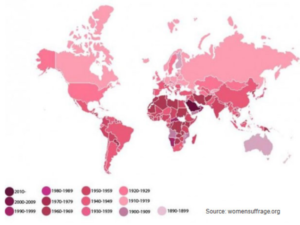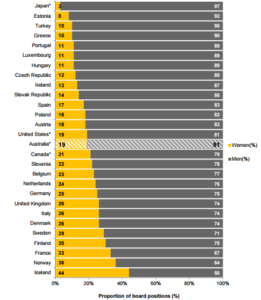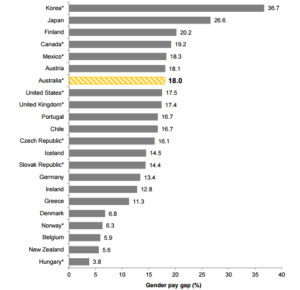Saudi Arabia was the last country to allow women to vote and females to be elected, even though with considerable limitations still. Women are now in a much better position on the fight that began one full century ago.
December 2015 was the turning point for women in Saudi Arabia. And the first country to grant national-level voting rights to women was the self-governing British colony of New Zealand, which passed the Electoral Bill in September 1893.
It was needed over a century for all women around the world to experience, conquer the right to somehow influence on their countries’ directions.
Still, it is a long process in some countries more than others to overcome the existing limitations, but a huge step has been made.
A MILESTONE OF A FIGHT THAT BEGAN ONE FULL CENTURY AGO
The right to suffrage was a key instrument for women to start to intervene in government resolutions, and the first actions towards this right started in the early 1800’s in US and UK.
The figure below shows the dates when women got their right to vote by country. And as you can see, the right to vote is still recent in some countries.

INTERNATIONAL WOMEN’S DAY – A LITTLE BIT OF HISTORY
The International Women’s Day celebration on 8 March was declared by UN (United Nations) in 1975 during the International Women’s Year.
But the first reference to Women’s organised movement happened in US at the first National Woman’s Day on 28 February, 1909 with the protest against working conditions promoted by the socialist party.
Later in 1910, during the Socialist International meeting in Copenhagen, the International Women’s Day was established to honor the movement for women’s rights and to build support for achieving universal suffrage for women.
This movement became an inspiration for women in Russia during the World War I (1914-1918) which decided to protest against the bad work conditions, anger and War which prevailed at that time. The movement was known as “Bread and Peace“ and it happened on the last Sunday in February (8 March on the Gregorian calendar).
All these sacrifices of women fighting for more rights cannot be forgotten, and in my opinion we need to celebrate. Celebration is important not only to educate the new generations but also to inspire us to continue to change the history for the better.
FIGHT FOR EQUAL WORKING RIGHTS
Equal working rights are still a concern where women feel discriminated on many occasions. Having worked in both Australia and Portugal, it gives me the opportunity to analyse and to compare both realities.
During my career, I noticed women in key positions experiencing higher levels of pressure compared to men in similar positions. And still, the majority of top level positions were held by men.
Personally, I had to express myself a little bit stronger to make my point in a male environment on some occasions, and in terms of salary I felt underpaid. Actually, this is one of the reasons I am starting my own business in a different area.
I am so excited to bring to the world a more feminine culture, based on cooperation, modesty, caring for the weak and quality of life.
The way to do business is changing. As Simon Sinek says, the way to do business is not to sacrifice others so that you can gain, but rather you are willing to sacrifice yourself so others can gain.
To better understand the current reality, I selected three aspects: gender composition of boards, managerial positions and salary gap. The objective is to show how women have progressed in predominately male environments. The countries in this analysis are part of OECD – Organisation for Economic Co-Operation and Development.
WHERE ARE WE TODAY IN THE FIGHT THAT BEGAN ONE FULL CENTURY AGO?
1 – Gender composition of board on the largest publicly listed companies
The figure below displays the gender composition of board on publicly listed companies across all 28 available countries (2014/2015). Results are ordered from the lowest to the highest percentage of women on boards.
 Recent statistics (2014-2015) reveal that men still hold the majority of board positions across all the countries.
Recent statistics (2014-2015) reveal that men still hold the majority of board positions across all the countries.
Only Iceland appears to have achieved equitable representation of women and men on boards (44% women compared to 56% men).
Women account for only one in five board members in Australia (19%) and in Portugal represents 11% against 89% of the positions held by men.
2 – Proportion of female and male employees who are managers
The figure below displays the proportion of female and male employees who are managers across all 30 available countries (2015). Results are ordered from the highest to the lowest percentage of female employees who are managers. (ranks: top-down)

As you can see, there is a higher proportion of working men holding managerial positions than working women.
Australia has the highest proportion of female employees that are managers (8.9%), and the second highest proportion of male employees that are managers (13.3%).
Comparatively, Portugal ranks in 12th position in both genders, with 9.1% of men employed holding management positions and only 5.3% of women employed in managerial positions.
3 – Gender pay gap
The figure below displays the gender pay gap by the 22 available countries (2013/2014). Results are ordered from the largest to the smallest gender pay gap. (ranks: bottom-up)

There is a gender pay gap favouring men in every country. Only five countries have gender pay gaps below 10%: Denmark; Norway; Belgium; New Zealand; and Hungary.
Three countries have gender pay gaps that exceed 20%: Korea; Japan; and Finland. Australia ranks 16th, with a gender pay gap of 18.0% and Portugal slightly better with a gender gap of 16.7% (13th rank).
WHERE TO GO FROM HERE
Yes, there is still a lot of work to do especially in less developed countries where the power positions continue in men’s hands, and women are struggling and suffering.
And UN, as an international organization, has a key role in promoting activities to help women in this process.
I learned though, that we also have a key role and we need individually to take initiative and co-create. Read here 3 advices to face the 9-5 cycle trend.
Being part of empowering groups helps to get motivated and inspired. And nowadays, with the internet, we became closer and you can use this channel to connect and interface with other people and create positive movements.
International Women’s Day is a time to reflect on progress made, to call for change and to celebrate acts of courage and determination by ordinary women who have played an extraordinary role in the history of their countries and communities – United Nations
Do you know anyone who would find this useful? Could you please share with them.
Your Friend,

References:
https://www.wgea.gov.au/sites/default/files/20160428_International_gender_equality_statistics_factsheet.pdf [Accessed 06/03/2017, pg.3, 7, 8]
You may also like:
Hi there!! I’m an open-minded being, lifelong learner, positive, heart-centred, relationships – oriented, social change agent and well-being advocate. I’m committed to make my life shine every single moment and I’m inviting you to do the same.
My philosophy is to live life with passion and purpose that includes to make a positive contribution for a better world, starting with simple gestures. Join me on this journey.♥♥♥
*** Ricardina Silva ***







It’s clear that we still have to keep pushing boundaries when it comes to equality, but I think we’ve made significant progress. As women, we should be extremely proud!
Totally agree with you Camela. Thank you for sharing your opinion.
I love that you’re tackling these issues. Great information and so much work to be done!